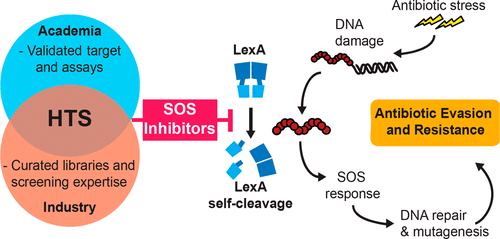当前位置:
X-MOL 学术
›
ACS Infect. Dis.
›
论文详情
Our official English website, www.x-mol.net, welcomes your feedback! (Note: you will need to create a separate account there.)
Inhibitors of LexA Autoproteolysis and the Bacterial SOS Response Discovered by an Academic–Industry Partnership
ACS Infectious Diseases ( IF 5.3 ) Pub Date : 2017-12-24 00:00:00 , DOI: 10.1021/acsinfecdis.7b00122 Charlie Y. Mo 1 , Matthew J. Culyba 1 , Trevor Selwood 1 , Jeffrey M. Kubiak 1 , Zachary M. Hostetler 1 , Anthony J. Jurewicz 2 , Paul M. Keller 2 , Andrew J. Pope 3 , Amy Quinn 2 , Jessica Schneck 2 , Katherine L. Widdowson 3 , Rahul M. Kohli 1
ACS Infectious Diseases ( IF 5.3 ) Pub Date : 2017-12-24 00:00:00 , DOI: 10.1021/acsinfecdis.7b00122 Charlie Y. Mo 1 , Matthew J. Culyba 1 , Trevor Selwood 1 , Jeffrey M. Kubiak 1 , Zachary M. Hostetler 1 , Anthony J. Jurewicz 2 , Paul M. Keller 2 , Andrew J. Pope 3 , Amy Quinn 2 , Jessica Schneck 2 , Katherine L. Widdowson 3 , Rahul M. Kohli 1
Affiliation

|
The RecA/LexA axis of the bacterial DNA damage (SOS) response is a promising, yet nontraditional, drug target. The SOS response is initiated upon genotoxic stress, when RecA, a DNA damage sensor, induces LexA, the SOS repressor, to undergo autoproteolysis, thereby derepressing downstream genes that can mediate DNA repair and accelerate mutagenesis. As genetic inhibition of the SOS response sensitizes bacteria to DNA damaging antibiotics and decreases acquired resistance, inhibitors of the RecA/LexA axis could potentiate our current antibiotic arsenal. Compounds targeting RecA, which has many mammalian homologues, have been reported; however, small-molecules targeting LexA autoproteolysis, a reaction unique to the prokaryotic SOS response, have remained elusive. Here, we describe the logistics and accomplishments of an academic–industry partnership formed to pursue inhibitors against the RecA/LexA axis. A novel fluorescence polarization assay reporting on RecA-induced self-cleavage of LexA enabled the screening of 1.8 million compounds. Follow-up studies on select leads show distinct activity patterns in orthogonal assays, including several with activity in cell-based assays reporting on SOS activation. Mechanistic assays demonstrate that we have identified first-in-class small molecules that specifically target the LexA autoproteolysis step in SOS activation. Our efforts establish a realistic example for navigating academic–industry partnerships in pursuit of anti-infective drugs and offer starting points for dedicated lead optimization of SOS inhibitors that could act as adjuvants for current antibiotics.
中文翻译:

产学合作发现的LexA自蛋白水解抑制剂和细菌SOS反应
细菌DNA损伤(SOS)反应的RecA / LexA轴是一种有前途的但非传统的药物靶标。DNA损伤传感器RecA诱导SOS阻遏物LexA进行自身蛋白水解后,会在遗传毒性胁迫下引发SOS反应,从而抑制可介导DNA修复并加速诱变的下游基因。由于对SOS反应的遗传抑制使细菌对破坏DNA的抗生素敏感,并降低了获得性耐药,因此RecA / LexA轴抑制剂可以增强我们目前的抗生素库。已经报道了靶向RecA的化合物,它具有许多哺乳动物的同源物。然而,靶向LexA自蛋白水解的小分子(原核SOS反应特有的反应)仍然难以捉摸。这里,我们描述了学术界与工业界建立伙伴关系以寻求针对RecA / LexA轴的抑制剂的物流和成就。一种新颖的荧光偏振测定报告了RecA诱导的LexA自我裂解,可以筛查180万种化合物。对选定引线的后续研究显示了正交测定中的不同活性模式,包括一些在报告SOS活化的基于细胞的测定中具有活性的模式。机械分析表明,我们已经鉴定出了一流的小分子,它们专门针对SOS激活中的LexA自蛋白水解步骤。我们的努力为在学术界与工业界之间的合作中寻求抗感染药物建立了一个现实的例子,并为优化SOS抑制剂的潜在铅优化提供了起点,SOS抑制剂可以作为当前抗生素的佐剂。
更新日期:2017-12-24
中文翻译:

产学合作发现的LexA自蛋白水解抑制剂和细菌SOS反应
细菌DNA损伤(SOS)反应的RecA / LexA轴是一种有前途的但非传统的药物靶标。DNA损伤传感器RecA诱导SOS阻遏物LexA进行自身蛋白水解后,会在遗传毒性胁迫下引发SOS反应,从而抑制可介导DNA修复并加速诱变的下游基因。由于对SOS反应的遗传抑制使细菌对破坏DNA的抗生素敏感,并降低了获得性耐药,因此RecA / LexA轴抑制剂可以增强我们目前的抗生素库。已经报道了靶向RecA的化合物,它具有许多哺乳动物的同源物。然而,靶向LexA自蛋白水解的小分子(原核SOS反应特有的反应)仍然难以捉摸。这里,我们描述了学术界与工业界建立伙伴关系以寻求针对RecA / LexA轴的抑制剂的物流和成就。一种新颖的荧光偏振测定报告了RecA诱导的LexA自我裂解,可以筛查180万种化合物。对选定引线的后续研究显示了正交测定中的不同活性模式,包括一些在报告SOS活化的基于细胞的测定中具有活性的模式。机械分析表明,我们已经鉴定出了一流的小分子,它们专门针对SOS激活中的LexA自蛋白水解步骤。我们的努力为在学术界与工业界之间的合作中寻求抗感染药物建立了一个现实的例子,并为优化SOS抑制剂的潜在铅优化提供了起点,SOS抑制剂可以作为当前抗生素的佐剂。



























 京公网安备 11010802027423号
京公网安备 11010802027423号